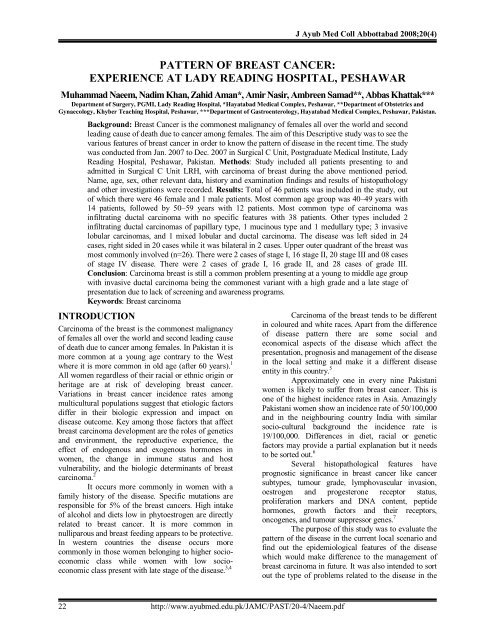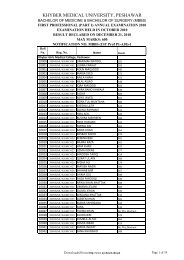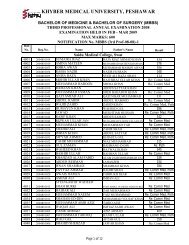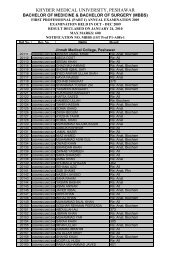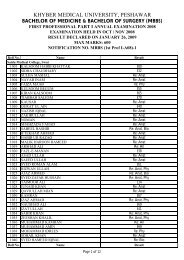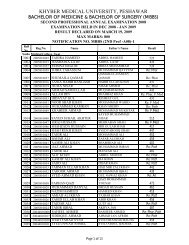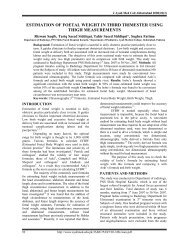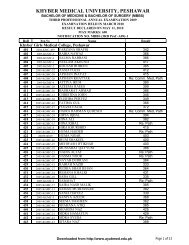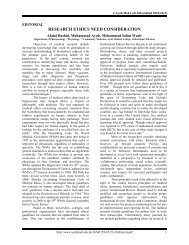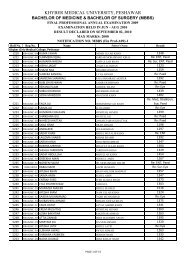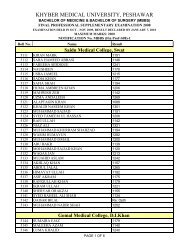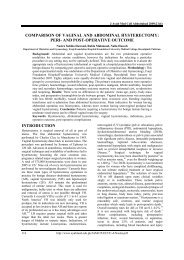pattern of breast cancer - Ayub Medical College
pattern of breast cancer - Ayub Medical College
pattern of breast cancer - Ayub Medical College
You also want an ePaper? Increase the reach of your titles
YUMPU automatically turns print PDFs into web optimized ePapers that Google loves.
J <strong>Ayub</strong> Med Coll Abbottabad 2008;20(4)<br />
PATTERN OF BREAST CANCER:<br />
EXPERIENCE AT LADY READING HOSPITAL, PESHAWAR<br />
Muhammad Naeem, Nadim Khan, Zahid Aman*, Amir Nasir, Ambreen Samad**, Abbas Khattak***<br />
Department <strong>of</strong> Surgery, PGMI, Lady Reading Hospital, *Hayatabad <strong>Medical</strong> Complex, Peshawar, **Department <strong>of</strong> Obstetrics and<br />
Gynaecology, Khyber Teaching Hospital, Peshawar, ***Department <strong>of</strong> Gastroenterology, Hayatabad <strong>Medical</strong> Complex, Peshawar, Pakistan.<br />
Background: Breast Cancer is the commonest malignancy <strong>of</strong> females all over the world and second<br />
leading cause <strong>of</strong> death due to <strong>cancer</strong> among females. The aim <strong>of</strong> this Descriptive study was to see the<br />
various features <strong>of</strong> <strong>breast</strong> <strong>cancer</strong> in order to know the <strong>pattern</strong> <strong>of</strong> disease in the recent time. The study<br />
was conducted from Jan. 2007 to Dec. 2007 in Surgical C Unit, Postgraduate <strong>Medical</strong> Institute, Lady<br />
Reading Hospital, Peshawar, Pakistan. Methods: Study included all patients presenting to and<br />
admitted in Surgical C Unit LRH, with carcinoma <strong>of</strong> <strong>breast</strong> during the above mentioned period.<br />
Name, age, sex, other relevant data, history and examination findings and results <strong>of</strong> histopathology<br />
and other investigations were recorded. Results: Total <strong>of</strong> 46 patients was included in the study, out<br />
<strong>of</strong> which there were 46 female and 1 male patients. Most common age group was 40–49 years with<br />
14 patients, followed by 50–59 years with 12 patients. Most common type <strong>of</strong> carcinoma was<br />
infiltrating ductal carcinoma with no specific features with 38 patients. Other types included 2<br />
infiltrating ductal carcinomas <strong>of</strong> papillary type, 1 mucinous type and 1 medullary type; 3 invasive<br />
lobular carcinomas, and 1 mixed lobular and ductal carcinoma. The disease was left sided in 24<br />
cases, right sided in 20 cases while it was bilateral in 2 cases. Upper outer quadrant <strong>of</strong> the <strong>breast</strong> was<br />
most commonly involved (n=26). There were 2 cases <strong>of</strong> stage I, 16 stage II, 20 stage III and 08 cases<br />
<strong>of</strong> stage IV disease. There were 2 cases <strong>of</strong> grade I, 16 grade II, and 28 cases <strong>of</strong> grade III.<br />
Conclusion: Carcinoma <strong>breast</strong> is still a common problem presenting at a young to middle age group<br />
with invasive ductal carcinoma being the commonest variant with a high grade and a late stage <strong>of</strong><br />
presentation due to lack <strong>of</strong> screening and awareness programs.<br />
Keywords: Breast carcinoma<br />
INTRODUCTION<br />
Carcinoma <strong>of</strong> the <strong>breast</strong> is the commonest malignancy<br />
<strong>of</strong> females all over the world and second leading cause<br />
<strong>of</strong> death due to <strong>cancer</strong> among females. In Pakistan it is<br />
more common at a young age contrary to the West<br />
where it is more common in old age (after 60 years). 1<br />
All women regardless <strong>of</strong> their racial or ethnic origin or<br />
heritage are at risk <strong>of</strong> developing <strong>breast</strong> <strong>cancer</strong>.<br />
Variations in <strong>breast</strong> <strong>cancer</strong> incidence rates among<br />
multicultural populations suggest that etiologic factors<br />
differ in their biologic expression and impact on<br />
disease outcome. Key among those factors that affect<br />
<strong>breast</strong> carcinoma development are the roles <strong>of</strong> genetics<br />
and environment, the reproductive experience, the<br />
effect <strong>of</strong> endogenous and exogenous hormones in<br />
women, the change in immune status and host<br />
vulnerability, and the biologic determinants <strong>of</strong> <strong>breast</strong><br />
carcinoma. 2<br />
It occurs more commonly in women with a<br />
family history <strong>of</strong> the disease. Specific mutations are<br />
responsible for 5% <strong>of</strong> the <strong>breast</strong> <strong>cancer</strong>s. High intake<br />
<strong>of</strong> alcohol and diets low in phytoestrogen are directly<br />
related to <strong>breast</strong> <strong>cancer</strong>. It is more common in<br />
nulliparous and <strong>breast</strong> feeding appears to be protective.<br />
In western countries the disease occurs more<br />
commonly in those women belonging to higher socioeconomic<br />
class while women with low socioeconomic<br />
class present with late stage <strong>of</strong> the disease. 3,4<br />
Carcinoma <strong>of</strong> the <strong>breast</strong> tends to be different<br />
in coloured and white races. Apart from the difference<br />
<strong>of</strong> disease <strong>pattern</strong> there are some social and<br />
economical aspects <strong>of</strong> the disease which affect the<br />
presentation, prognosis and management <strong>of</strong> the disease<br />
in the local setting and make it a different disease<br />
entity in this country. 5<br />
Approximately one in every nine Pakistani<br />
women is likely to suffer from <strong>breast</strong> <strong>cancer</strong>. This is<br />
one <strong>of</strong> the highest incidence rates in Asia. Amazingly<br />
Pakistani women show an incidence rate <strong>of</strong> 50/100,000<br />
and in the neighbouring country India with similar<br />
socio-cultural background the incidence rate is<br />
19/100,000. Differences in diet, racial or genetic<br />
factors may provide a partial explanation but it needs<br />
to be sorted out. 6<br />
Several histopathological features have<br />
prognostic significance in <strong>breast</strong> <strong>cancer</strong> like <strong>cancer</strong><br />
subtypes, tumour grade, lymphovascular invasion,<br />
oestrogen and progesterone receptor status,<br />
proliferation markers and DNA content, peptide<br />
hormones, growth factors and their receptors,<br />
oncogenes, and tumour suppressor genes. 7<br />
The purpose <strong>of</strong> this study was to evaluate the<br />
<strong>pattern</strong> <strong>of</strong> the disease in the current local scenario and<br />
find out the epidemiological features <strong>of</strong> the disease<br />
which would make difference to the management <strong>of</strong><br />
<strong>breast</strong> carcinoma in future. It was also intended to sort<br />
out the type <strong>of</strong> problems related to the disease in the<br />
22<br />
http://www.ayubmed.edu.pk/JAMC/PAST/20-4/Naeem.pdf
J <strong>Ayub</strong> Med Coll Abbottabad 2008;20(4)<br />
local setting. Furthermore the results <strong>of</strong> such study can<br />
provide data for epidemiological interests and help<br />
compare the local data with data from other parts <strong>of</strong><br />
the country and regional and international research.<br />
PATIENTS AND METHODS<br />
The study was conducted in Surgical C Unit,<br />
Postgraduate <strong>Medical</strong> Institute <strong>of</strong> Lady Reading<br />
Hospital, Peshawar, from January, 2007 to December<br />
2007. It was a descriptive study.<br />
Inclusion criteria included all those patients<br />
who were admitted with <strong>breast</strong> carcinoma in the above<br />
mentioned setting during the above mentioned<br />
duration. Exclusion criteria included those patients<br />
who refused to undergo assessment and treatment in<br />
the unit, those who left against medical advice after a<br />
provisional diagnosis was made and those patients<br />
who refused to provide informed consent for their<br />
treatment and inclusion in the study. Patients’ age, sex<br />
and history <strong>of</strong> disease and investigations results were<br />
recorded. Those patients having metastasis in <strong>breast</strong><br />
with primary tumour outside <strong>breast</strong> were excluded<br />
from the study.<br />
All the patients were counselled about their<br />
conditions. Informed consent was taken from all<br />
patients for their management from history taking to<br />
surgical procedures and for inclusion in the study data.<br />
Data collection was done with the help <strong>of</strong> a Performa<br />
in which all the related data was collected. The<br />
analysis was performed using SPSS version 10. Name,<br />
age and gender <strong>of</strong> the patients and other relevant data<br />
were recorded.<br />
RESULTS<br />
During the above mentioned period <strong>of</strong> 12 months a<br />
total <strong>of</strong> 46 patients were included in the study. There<br />
were 45 female and 1 male patient. The most common<br />
age group was 40–49 years with 14 cases (30.4%),<br />
then 50-59 years with 12 cases (26.0%), followed by<br />
30–39 years with 10 cases (21.73%), 60-69 years 07<br />
cases (15.21%), 20–29 years 1 case (2.17%), 70–79<br />
years 1 case (2.17%) and there was also one case<br />
(2.17%) <strong>of</strong> 80 years and above age group.<br />
Infiltrating ductal carcinoma with nonspecific<br />
features was the commonest type, found in 38<br />
patients (82.6%) out <strong>of</strong> a total <strong>of</strong> 46. Other types<br />
included 2 cases (4.35%) <strong>of</strong> infiltrating ductal<br />
carcinomas <strong>of</strong> papillary type, 1 case (2.17%) <strong>of</strong><br />
mucinous type and 1 case (2.17%) <strong>of</strong> medullary type,<br />
3 case (6.52%) <strong>of</strong> invasive lobular carcinoma and 1<br />
case <strong>of</strong> mixed lobular and ductal carcinoma. Two<br />
patients presented with metastasis in the <strong>breast</strong> having<br />
primary tumor elsewhere. One <strong>of</strong> these patients had<br />
choriocarcinoma and the other had non-hodgkin’s<br />
lymphoma. These patients were excluded from the<br />
study.<br />
The disease was found on the left side in 24<br />
(52.17%), on the right side in 20 (43.47%) and there<br />
were two cases (4.35%) <strong>of</strong> bilateral <strong>breast</strong> <strong>cancer</strong>.<br />
Upper outer quadrant with 26 cases (56.5%) was most<br />
commonly involved, lower outer quadrant was<br />
involved in 2 (4.35%), central area in 6 (13.0%) and<br />
there were 2 cases (4.35%) each <strong>of</strong> upper inner and<br />
lower inner quadrant. In 8 cases (17.39%) two or more<br />
than two quadrants were involved.<br />
Stages in which disease presented included 2<br />
(4.35%) cases <strong>of</strong> stage I, 16 (34.78%) stage II, 20<br />
(43.47%) stage III, and 8(17.39%) stage IV cases.<br />
There were 2 (4.35%) cases <strong>of</strong> grade I, 16 (34.78%)<br />
cases <strong>of</strong> grade II, and 27(58.69%) cases <strong>of</strong> grade III<br />
disease.<br />
Number<br />
Number<br />
20<br />
18<br />
16<br />
14<br />
12<br />
10<br />
8<br />
6<br />
4<br />
2<br />
0<br />
14<br />
12<br />
10<br />
8<br />
6<br />
4<br />
2<br />
0<br />
1<br />
10<br />
14 12<br />
7<br />
1 1<br />
20-29 30-39 40-49 50-59 60-69 70-79 ≥80<br />
2<br />
Age Group<br />
Figure-1: Age Distribution<br />
16<br />
stag I stag II stage III stage IV<br />
Stage<br />
Figure-2: Stage at presentation <strong>of</strong> disease<br />
Table-1: Number <strong>of</strong> cases <strong>of</strong> different types <strong>of</strong><br />
<strong>breast</strong> carcinoma<br />
Type Sutype Cases %<br />
Lobular<br />
In situ 0 -<br />
Invasive 3 6.5<br />
Ductal<br />
In situ 0 -<br />
Non-specific 38 82.6<br />
Medullary 1 2.17<br />
Mucinous 1 2.17<br />
Specific Tubular 0 -<br />
papillary 2 4.35<br />
inflammatory 0 -<br />
Others Paget’s disease <strong>of</strong> nipple 0 -<br />
Mixed lobular and ductal 1 2.17<br />
Infiltrating<br />
Table-2 : Grades <strong>of</strong> <strong>breast</strong> <strong>cancer</strong> at presentation<br />
Grade <strong>of</strong> disease Number <strong>of</strong> cases percentage<br />
I 2 4.35<br />
II 16 34.7<br />
III 28 60.86<br />
20<br />
8<br />
http://www.ayubmed.edu.pk/JAMC/PAST/20-4/Naeem.pdf 23
J <strong>Ayub</strong> Med Coll Abbottabad 2008;20(4)<br />
Table-3: Comparison with local studies<br />
Author<br />
Publication<br />
Year /location Cases Most common type<br />
Common age<br />
group (yrs) Stage<br />
Common side<br />
and quadrant<br />
Aftab ML 8 1998/ Lahore 51 Infiltrating ductal Ca 30–49 III, IV (47%) Left (58%)<br />
Siddiqui M 9 2000/ Karachi 572 Infiltrating ductal Ca (81%) 40–60 III (70%)<br />
Siddiqui K 10 2001/ Lahore 181 41–50 (31%), III (54%)<br />
31–40 (26%)<br />
Baloch TA 11 2006/ Karachi 50 Infiltrating ductal Ca (81%) 40–60 III (70%) Right (76%),<br />
upper outer (36%)<br />
Batool M 12 2005/ Lahore 205 Infiltrating ductal Ca (85%) 34.5 (Mean) III (60%)<br />
Aslam MN 13 2006/ Lahore 156 Infiltrating ductal Ca (94%) 31–45 yrs III (56%), II (22%)<br />
Qureshi S 14 2007/ Karachi Infiltrating ductal Ca (90%)
J <strong>Ayub</strong> Med Coll Abbottabad 2008;20(4)<br />
Importantly screening and awareness<br />
programs on behalf <strong>of</strong> health authorities in developed<br />
countries contribute to earlier detection <strong>of</strong> disease and<br />
thus making curative treatment much more likely to be<br />
successful and thus improving overall survival rates.<br />
The present study has clearly shown that<br />
<strong>breast</strong> <strong>cancer</strong> presents in the middle age group at an<br />
advance stage (III and IV) in the local setup. These<br />
facts may indicate that the disease in this area is<br />
probably more aggressive and that there may be social<br />
and economical reasons and lack <strong>of</strong> awareness due to<br />
which patients do not come up for medical<br />
consultation in early stages <strong>of</strong> the disease. Public<br />
health awareness needs to be directed towards the<br />
societal influences that impact <strong>breast</strong> carcinoma<br />
development.<br />
CONCLUSION<br />
Carcinoma <strong>breast</strong> is still a common problem<br />
presenting at a young to middle age group with<br />
invasive ductal carcinoma being the commonest<br />
variant with a high grade and a late stage presentation<br />
due to lack <strong>of</strong> screening and awareness programs.<br />
REFERENCES<br />
1. Mahmood S, Rana TF, Ahmad M. Common determinants <strong>of</strong><br />
Ca Breast–a case control study in Lahore. Ann King Edward<br />
Med Coll 2006;12:227–8.<br />
2. Hunter CP. Epidemiology, stage at diagnosis, and tumor<br />
biology <strong>of</strong> <strong>breast</strong> carcinoma in multiracial and multiethnic<br />
populations. Cancer. 2000;88(5 Suppl):1193–202.<br />
3. Russel RCG, William NS, Bulstrode CJK. Bailey and Love’s<br />
Short Practice <strong>of</strong> Surgery. 24 th ed. London; Arrnold; 2004.<br />
4. Cuschieri A, Steele RJC, Moossa AR. Essential Surgical<br />
Practice.4 th ed. New York: Oxford University Press; 2002.<br />
5. Ahmed R, Shaikh H, Hasan S. Is carcinoma <strong>breast</strong> a different<br />
disease in Pakistani population? J Pak Med Assoc 1997;47:114–6.<br />
6. Sohail S, Alam SN. Breast <strong>cancer</strong> in Pakistan–awareness and<br />
early detection. J Coll Physicians Surg Pak 2007;17:711–2.<br />
7. Alahwal MS. HER-2 positivity and correlations with other<br />
histopathologic features in Breast Cancer patients–hospital<br />
basd study. J Pak Med Assoc 2006;56:65–8.<br />
8. Aftab ML, Rashid A. A Clinico Pathological Study <strong>of</strong><br />
Carcinoma Breast. Pak J Health 1998;35(3-4):96–8.<br />
9. Siddiqui M, Kayani N, Sulaiman S, Hussainy A, Shah S,<br />
Muzaffar S. Breast carcinoma in Pakistani females: a<br />
morphological study <strong>of</strong> 572 <strong>breast</strong> specimens. J Pak Med<br />
Assoc 2000;50:174–7.<br />
10. Siddiqui K, Rasool MI. Pattern <strong>of</strong> Breast Diseases:<br />
Preliminary Report <strong>of</strong> Breast Clinic. J Coll Physicians Surg<br />
Pak 2001;11:497–500.<br />
11. Baloch TA, Iqbal P. Breast carcinoma in Karachi Clinical &<br />
Pathological Features. Med Channel 2006;12:47–8.<br />
12. Batool M, Arian M, Gardezi J. An experience with <strong>breast</strong><br />
disease in a surgical unit <strong>of</strong> a teaching hospital <strong>of</strong> Lahore.<br />
Biomedica 2005;21:108–12.<br />
13. Aslam MN, Ansari AK, Siddique A, Imran M. Carcinoma<br />
<strong>breast</strong>, late presentation-a big concern. Ann King Edward<br />
Med Coll 2006;2:317–9.<br />
14. Qureshi S, Ghazanfar S, Memon SA, Attaullah, Quraishy<br />
MS, Sultan N. Five years experience <strong>of</strong> carcinoma <strong>breast</strong>. J<br />
Surg Pak 2007;12:52–5.<br />
15. Gilani GM, Kamal S, Akhter A S. A differential study <strong>of</strong><br />
Breast Cancer Patients in Punjab, Pakistan.J Pak Med Assoc<br />
Oct 2003;53:478–81.<br />
16. Kuraparthy S, Reddy KM, Yadagiri LA, Yutla M, Venkata<br />
PB, Kadainti SV et al. Epidemiology and <strong>pattern</strong>s <strong>of</strong> care for<br />
invasive <strong>breast</strong> carcinoma at a community hospital in<br />
Southern India. World J Surg Oncol 2007;5:56.<br />
17. Klon<strong>of</strong>f-Cohen HS, Schaffroth LB, Edelstein SL, Molgaard<br />
C, Saltzstein SL. Breast <strong>cancer</strong> histology in Caucasians,<br />
African Americans, Hispanics, Asians, and Pacific Islanders.<br />
Ethn Health. 1998;3:189–98.<br />
18. Yip CH; Taib NA; Mohamed I. Epidemiology <strong>of</strong> <strong>breast</strong><br />
<strong>cancer</strong> in Malaysia. Asian Pac J Cancer Prev. 2006;7:369–74.<br />
19. Arndt V, Stürmer T, Stegmaier C, Ziegler H, Dhom G,<br />
Brenner H. Socio-demographic factors, health behavior and<br />
late-stage diagnosis <strong>of</strong> <strong>breast</strong> <strong>cancer</strong> in Germany: a<br />
population-based study. J Clin Epidemiol 2001;54:719–27.<br />
20. Oluwole SF, Ali AO, Adu A, Blane BP, Barlow B, Oropeza<br />
R, et al. Impact <strong>of</strong> a <strong>cancer</strong> screening program on <strong>breast</strong><br />
<strong>cancer</strong> stage at diagnosis in a medically underserved urban<br />
community. J Am Coll Surg 2003;196:180–8.<br />
Address for Correspondence:<br />
Dr. Mohammad Naeem, Clinic No. 115, Ground floor, Said Anwar <strong>Medical</strong> Centre, Dabgari Garden, Peshawar,<br />
Pakistan. Tel: +92-314-9960600<br />
Email: naeemkhattak74@gmail.com<br />
http://www.ayubmed.edu.pk/JAMC/PAST/20-4/Naeem.pdf 25


